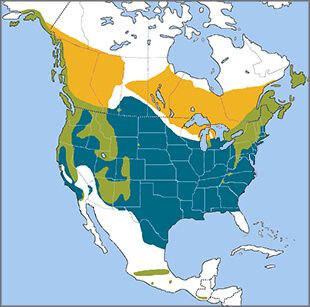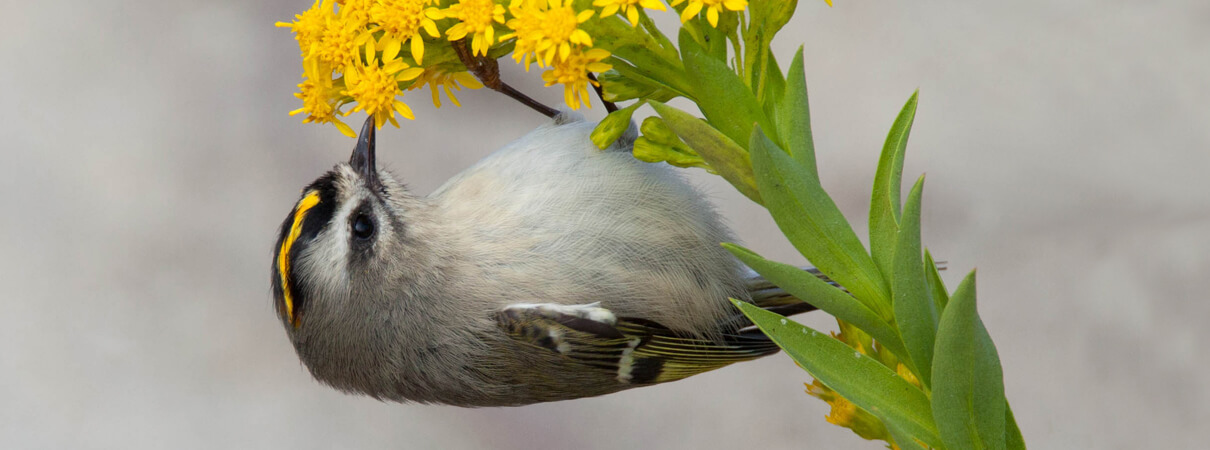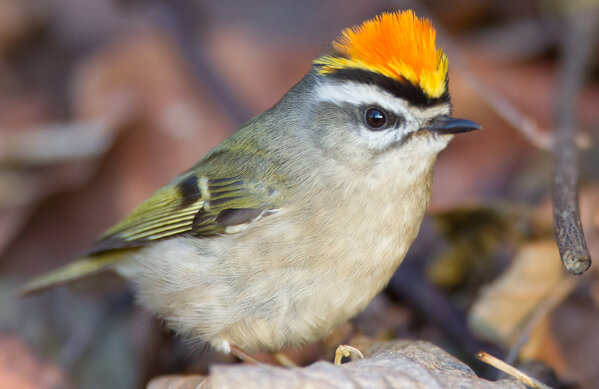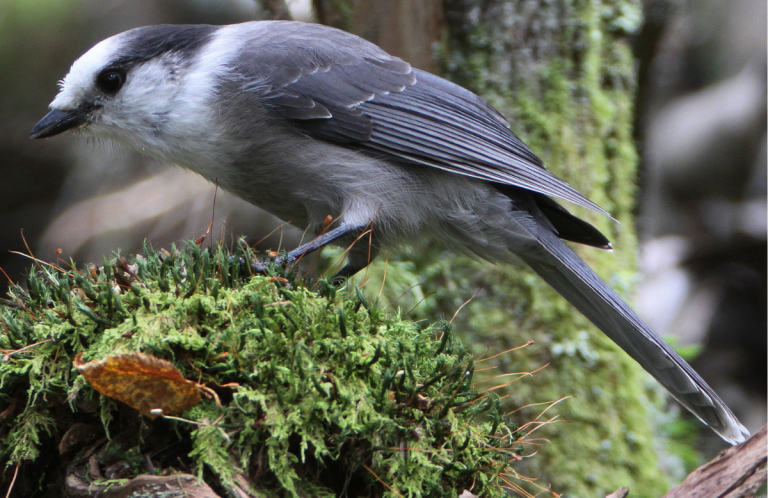
Golden-crowned Kinglet range map, Birds of North America, https://birdsna.org, maintained by the Cornell Lab of Ornithology.
The tiny Golden-crowned Kinglet is one of the world's smallest perching birds. At only five grams (about the weight of two pennies), it's not much larger than a Ruby-throated Hummingbird. Its genus name, Regulus, means “little king,” and refers to the bright yellow and orange feathers that crown this bird's black-and-white-striped head.
Perpetual Motion
Unlike other insectivorous birds such as the Olive-sided Flycatcher and Golden-winged Warbler, the Golden-crowned Kinglet is able to find enough insect food to remain in the U.S. and Mexico during the winter. Its secret? Perpetual motion! This little bird always seems to be on the move, constantly foraging for insects and their eggs, from high in the trees all the way down to low shrubs and weeds.
This non-stop activity is essential. A Golden-crowned Kinglet needs to eat constantly to fuel a high body temperature and metabolic rate, both of which help combat the cold. If a kinglet goes without food for only a few hours during the day, it will starve and freeze to death.
The Golden-crowned Kinglet constantly flicks its wings as it moves about. This behavior makes the two kinglet species (the Ruby-crowned is the other) stand out from other small birds with which they flock, even in poor lighting. The Golden-crowned Kinglet's call, a high, thin seet-seet-seet, is also a good clue to its presence. Its song, usually heard only on its boreal breeding grounds, has a similar wiry quality — an ascending ti-ti-ti, followed by descending chatter. Listen to both here:
(Audio of Golden-crowned Kinglet call by Thomas Magarian, XC359340, accessible at www.xeno-canto.org/359340; Audio of Golden-crowned Kinglet song by Sue Riffe, XC419366, accessible at www.xeno-canto.org/419366.)
Northern Nester
Five subspecies of Golden-crowned Kinglet are recognized, including two resident populations in the mountains of Mexico and Guatemala. In the United States and Canada, the Golden-crowned Kinglet's breeding range includes the Appalachian Mountains, western mountains, and the Pacific Northwest. There, it primarily nests high in spruce and other coniferous trees, habitat that's shared by Blackburnian, Townsend's, and Cape May Warblers, and Pine Siskin.
In winter, Golden-crowned Kinglets are found across much of the United States and in parts of the east and west of Canada, in coniferous, mixed, and deciduous forests. As during their breeding season, from fall through early spring, these birds prefer to forage in spruce, fir, and pine trees. They often join small feeding flocks with other woodland birds such as the Downy Woodpecker, Brown Creeper, nuthatches, chickadees, and, in the southern half of their wintering range, the Ruby-crowned Kinglet. Golden-crowned Kinglets are almost always seen in pairs or groups of up to five individuals.
A Moveable Feast
The Golden-crowned Kinglet feeds on a range of insects, spiders, and other invertebrates and their eggs, ceaselessly gleaning along twigs, branches, vines, and stems in search of food. This non-stop forager hops quickly between branches, hangs upside down to examine the undersides of branches and foliage, and hovers while picking off tiny insects with its small, thin black bill. On the wing, it also deftly snags flying insects, and it has been seen drinking sap from sapsucker wells, visiting backyard suet feeders, and even eating small berries.

Golden-crowned Kinglet by Robert Dorman, Shutterstock
Small Bird, Big Clutch
For a tiny bird, the Golden-crowned Kinglet produces large clutches of eggs, usually eight or nine. It routinely raises two of these large broods per season. This unusual productivity offsets a high rate of winter mortality: About 87 percent perish every year, and unusually harsh winters can completely wipe out local populations.
Female Golden-crowned Kinglets begin nest-building by mid-April. The male assists in constructing the hammock-like nest, which is suspended beneath the thick needles and twigs of a spruce or other coniferous tree branch, providing effective cover from predators and late snowstorms. An outer layer of mosses, bark strips, spider webs, and caterpillar silk surrounds the nest, with a smaller, feather-lined cup nest within.
After the young from the first clutch fledge, the male will feed them while the female incubates a second set of eggs.
Kinglets Part of Widespread Bird Declines
Unfortunately, the Golden-crowned Kinglet is only one of a large number of bird species declining in the United States and Canada. A study just published in Science reveals that since 1970, breeding bird populations in the United States and Canada have declined by 29 percent, or almost 3 billion birds. The largest factor behind these declines is habitat loss and degradadation. Cat predation, collisions, and widespread pesticide use are also implicated in this troubling drop, while climate change is exacerbating many of these threats. (Read more in our fact sheet about threats to birds.)
ABC has a number of programs in place to tackle these threats, including our Cats Indoors program, which encourages pet owners to keep cats and birds safe; our Glass Collisions program, which offers solutions to birds hitting windows; and our Pesticides program, which works to block or restrict dangerous pesticides and other chemicals in homes, gardens, and agriculture, including neonicotinoids.
Our Policy team continues efforts to protect and reinforce legislation vital to bird conservation, including the Migratory Bird Treaty Act and the Endangered Species Act.
Take Action for Birds
- Please contact your legislators to ask for action at the federal level.
- See a factsheet on 7 Ways to Help Birds — and choose one (or a few) simple ways to help!
- Find out more about this study.
Donate now to help reverse widespread bird population declines!



















































